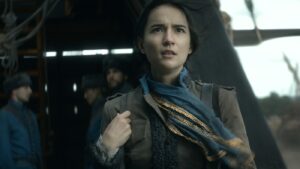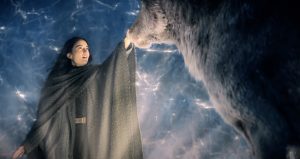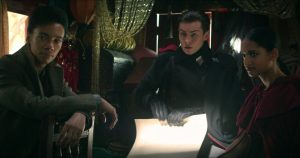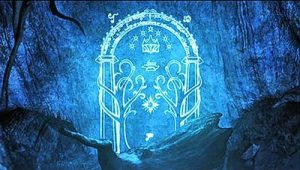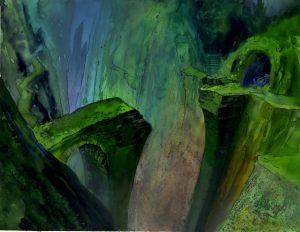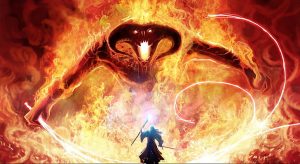SPOILERS FOR SHADOW AND BONE AHEAD!
Despite leaving Ketterdam and the home-turf of our Crows behind, Shadow And Bone‘s third episode is the first to feel like it splits focus almost evenly between the series’ two main storylines, and even slightly favors the Crows: whom we catch up with in West Ravka as they race to kidnap Alina Starkov (Jessie Mei Li) before someone else does and reaps the benefit – while Alina herself basically just wanders around the Little Palace, getting acquainted with various Grisha and having other characters exposit information to her that will be important later in the season.

Alina’s sequences are also nearly identical to the corresponding chunk of Shadow And Bone, the book on which the series is based – which should give you some idea of why that particular book is my least-favorite of Leigh Bardugo’s Grishaverse novels. They’re far more entertaining in the series thanks to Mei Li’s performance and the lavish production design on display in the Little Palace, but still could have benefited from a little trimming here and there.
Immediately, we start out with Alina narrating a letter to her best friend Mal Oretsev (Archie Renaux), whom she hasn’t had a chance to properly talk to since before entering the Shadow-Fold in episode one. Thankfully, the narration doesn’t completely halt the action in its tracks, but instead bleeds over a montage of Alina being prepared for her audience with the royal family of Ravka by the queen’s small army of servants – helmed by the fan-favorite Tailor, Genya Safin (Daisy Head). Shadow And Bone made the right choice by not explaining every Grisha’s powers upfront – allowing each one to make a big impression when they finally arrive, as Genya so undeniably does with her unique skillset.
Tailors have the ability to subtly alter or “modify” the human body, and Shadow And Bone‘s writing team seem well-aware of how easily that ability could cross over into the realm of problematic beauty standards and social commentary, based on how sparingly and precisely Genya’s powers are actually used – at first only to clean up Alina’s scars and bruises. Her physical appearance is never changed, an arrangement Alina insists upon after one of Genya’s maids makes a racist comment about Alina’s eyes that I feel would be irresponsible of me not to mention, given that some viewers of Asian descent have legitimate problems with this line and other instances of racism against Alina in the series.
As previously noted, the production design is absolutely stunning in all of the Little Palace sequences – many of which were filmed in real-life palaces and museums scattered around Budapest. The distinctive “Tzarpunk” flavor of Bardugo’s novels is on full display during the audience with Ravka’s royal family, whom Alina and The Darkling (Ben Barnes) are called upon to bedazzle with a light-show that’s ultimately more of the pompous pageantry they’re forced to partake in at the king’s behest.

I can’t not mention the fact that, during this sequence, in which Alina is finally welcomed into the ranks of the Grisha and instructed to make herself at home, the camera lingers on her embrace with an unnamed Grisha who is none other than Shadow And Bone‘s author Leigh Bardugo, fittingly appearing in the bright purple kefta of a Grisha Fabrikator – a creator and inventor. As a writer myself, I know it’s every author’s dream to someday experience even a fraction of the joy and wonderment Bardugo must have been feeling in that moment, witnessing her stories and characters come to life so vividly.
Alina’s story then starts to meander a bit. We’re whisked away to Grisha training, which is actually the one thing I’d have liked to see more of – but an embarrassingly quick fight sequence between Alina and Zoya Nazyalensky (Sujaya Dasgupta), her rival for The Darkling’s affection, ends with everyone realizing it would make more sense for Alina to practice using her powers rather than her fists. So she’s transported to another part of the palace grounds, to go meet a mysterious old woman named Baghra (Zoë Wanamaker), who almost immediately dismisses her with a warning to work past her self-doubt and insecurities. Then she goes to dinner, and the Grisha lecture her about not training enough.
Apart from just not being all that interesting, Alina’s story in this episode also interrupts the far more compelling Six Of Crows subplot at extremely awkward moments – leading to some dizzying tonal shifts as we jump from epic Volcra battles in the Shadow-Fold to more slow, uncomfortable, palatial plotting. Landing in West Ravka on the wrong side of the Fold and following the guidance of the suspicious Conductor (Howard Charles), Kaz Brekker (Freddy Carter) and his gang nearly come face-to-face with a character whom they’ll only finally meet in the finale, and who – if the books are to be trusted – will play a major part in all their future storylines: the Irish-accented Grisha Heartrender Nina Zenik (Danielle Galligan), who is supposed to meet them at the edge of the Fold and help them infiltrate the Little Palace.
But although fate intervenes to send Kaz and Nina’s storylines spiraling in opposite directions before they get a chance to meet, we as the audience get to follow both of them simultaneously – as Nina meets and forms a connection with her captor, Fjerdan Matthias Helvar (Calahan Skogman), who will one day become the sixth member of the Crows. Nina’s subplot, unfortunately, is never really given the time and attention it needs to feel essential rather than distracting (and, no offense to Skogman, but I’ve never liked Matthias and Skogman’s performance does nothing to change that) but it’s Nina’s introductory scene – in which she uses her Heartrender abilities to persuade her landlord to let her evade rent for what is clearly not the first time – that gives me hope her role in season two will reflect more of her charismatic personality from the books.

Shadow And Bone, luckily, has fan-favorites to go around: and this is the episode where I think we all fell even deeper in love with Jesper Fahey (Kit Young) – for me, this is the episode where I discovered what I was missing all those times I felt annoyed or even bored by some of his chapters in the Six Of Crows duology. But did Six Of Crows ever feature Jesper effortlessly slaughtering an entire pack of Volcra in the Shadow-Fold while clinging for dear life to an emotional support goat named Milo (unnamed goat)? No, I didn’t think so.
Out of all the fan-favorites introduced or prominently featured in this episode, from Genya to Jesper to Leigh Bardugo herself, it’s Milo who gets the last bleat, because the fandom has already embraced him as an honorary seventh member of the Crows – and honestly, given what we see of our actual sixth member in this episode, I’d be willing to leave open a slot for Milo on the team.
Episode Rating: 8/10
